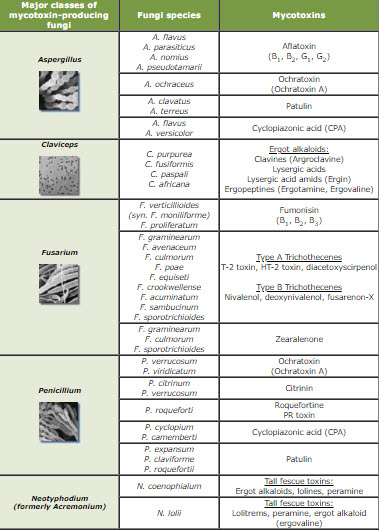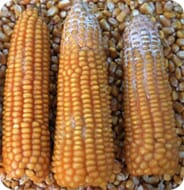Mycotoxins Effects on Poultry
Mycotoxins are highly toxic secondary metabolic products of molds on almost all agricultural commodities worldwide. They occur under natural conditions in feed as well as in food. Several studies proved that economic losses occur at all levels of food and feed production, including crop and animal production, processing and distribution. According to the FAO (Food and agriculture organization) 25% of the world's crop harvests are contaminated with mycotoxins.
 |
| Mycotoxins damages to the Poultry |
There are currently more than 400 mycotoxins known. There are six major classes of mycotoxins that frequently occur: aflatoxins, trichothecenes, fumonisins, zearalenone, ochratoxin and ergot alkaloids. They are formed by different kinds of fungi and each fungi species can produce more than one mycotoxin. The major classes of these mycotoxin-producing fungi are listed in the table below.
 |
| How mycotoxins affect poultry growth |
Mycotoxins differ in their structure, which explains the great variation of symptoms (see table: "Selected mycotoxins and their basic symptoms"). The main toxic effects are carcinogenicity, genotoxicity, nephrotoxicity, hepatotoxicity, oestrogenicity, reproductive disorders, immunosuppression or dermal effects. There are several factors which influence symptoms:
- Type of mycotoxins consumed, intake level and duration of exposure
- Animal species, sex, breed, age , general health, immune status
- Farm management (hygiene, temperature, production density )
- Possible synergism between mycotoxins simultaneously present in feeds
Each plant can be affected by more than one fungus and each of them can produce more than one mycotoxin. Consequently, there is a great probability that many mycotoxins are present in one feed, thus increasing the odds of interaction between mycotoxins and the occurrence of synergistic effects, which are of great concern in livestock health and productivity. Synergistic effects can already occur at low levels when the combined effects of two mycotoxins are much greater than the individual effects of each toxin alone. In contrast additive effects that occur when the combined effects of two mycotoxins are equal to the sum of the effects of each toxin given alone.
 |
| How mycotoxins affect chicken |
Mycotoxins are often invisible, tasteless, chemically stable and resistant to temperature and storage. They cannot be destroyed during the normal feed manufacturing processes.
Mycotoxin producing fungi can be divided into two groups:
- Field fungi (Fusarium sp.) produce mycotoxins in the field (pre-harvest)
- Storage fungi (Aspergillus and Penicillium sp.) occur after harvest (post-harvest)
However in special cases like under unusually hot or dry conditions Aspergillus and Penicillium species can also affect the grain on the field, and field fungi can continue growing and produce mycotoxins during transport and storage.


Mycotoxins are often invisible, tasteless, chemically stable and resistant to temperature and storage. They cannot be destroyed during the normal feed manufacturing processes.
Mycotoxin producing fungi can be divided into two groups:
- Field fungi (Fusarium sp.) produce mycotoxins in the field (pre-harvest)
- Storage fungi (Aspergillus and Penicillium sp.) occur after harvest (post-harvest)
However in special cases like under unusually hot or dry conditions Aspergillus and Penicillium species can also affect the grain on the field, and field fungi can continue growing and produce mycotoxins during transport and storage.





